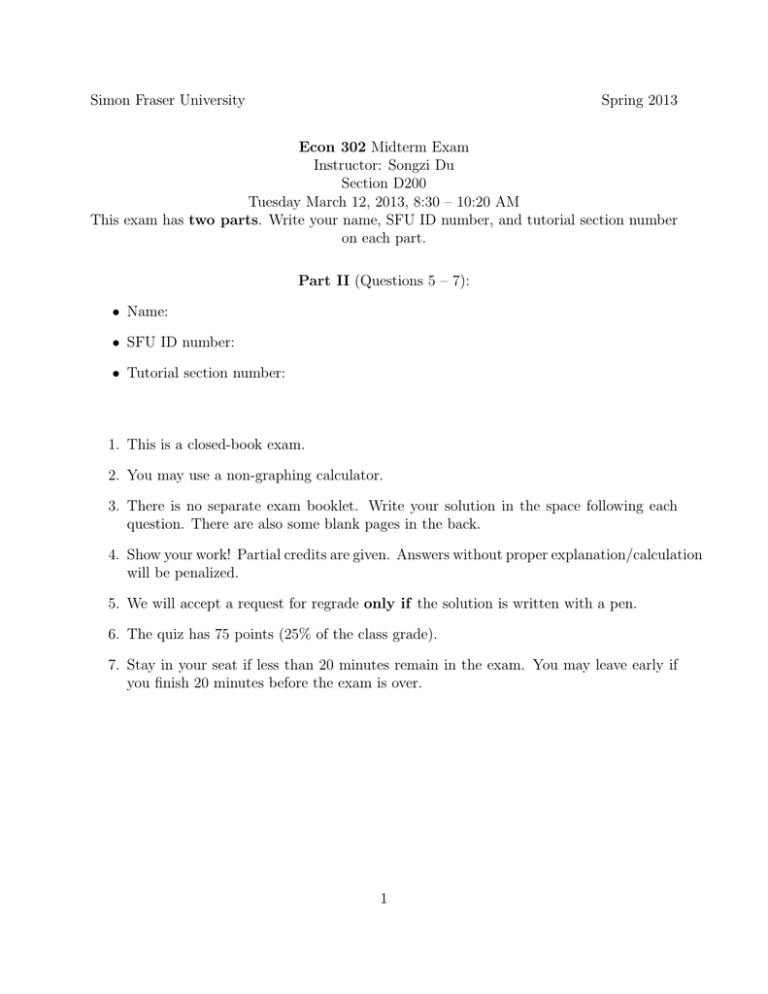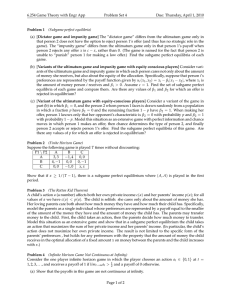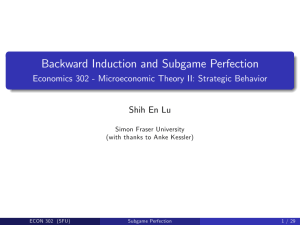Simon Fraser University Spring 2013 Econ 302 Midterm Exam Instructor: Songzi Du
advertisement

Simon Fraser University Spring 2013 Econ 302 Midterm Exam Instructor: Songzi Du Section D200 Tuesday March 12, 2013, 8:30 – 10:20 AM This exam has two parts. Write your name, SFU ID number, and tutorial section number on each part. Part II (Questions 5 – 7): • Name: • SFU ID number: • Tutorial section number: 1. This is a closed-book exam. 2. You may use a non-graphing calculator. 3. There is no separate exam booklet. Write your solution in the space following each question. There are also some blank pages in the back. 4. Show your work! Partial credits are given. Answers without proper explanation/calculation will be penalized. 5. We will accept a request for regrade only if the solution is written with a pen. 6. The quiz has 75 points (25% of the class grade). 7. Stay in your seat if less than 20 minutes remain in the exam. You may leave early if you finish 20 minutes before the exam is over. 1 5. (10 points) Player 1 and 2 are bargaining over a dollar. Player 1 moves first, proposing a division x (where 0 ≤ x ≤ 1) in which he gets x and Player 2 gets 1 − x, and Player 2 responds with Accept or Reject. If Player 2 accepts, they get the proposed division of (x, 1 − x), and the game ends; if Player 2 rejects, the game moves to the next stage. In the next stage, the dollar is shrunk 10% to 0.9 dollar, and Player 2 gets to propose a division y (where 0 ≤ y ≤ 0.9) in which he gets y and Player 1 gets 0.9 − y; Player 1 then responds with Accept or Reject, and the game ends. If Player 1 accepts, then they get the proposed division (0.9 − y, y); if Player 1 rejects, they get (0, 0). Find a subgame perfect equilibrium of this game. (Hint: draw the game tree to understand what is going on.) 2 3 6. (10 points) Nature chooses the ability of the student: with probability 0.5 he is of high ability, and with probability 0.5 he is of low ability. The student knows his type, and decides whether to go to the university. A firm then observes the educational background of the student (but not his ability), and decides whether to hire the student. The firm gets a payoff of 1 if it hires the high ability student, -1 if it hires the low ability student, and 0 if it does not hire. The high-ability student enjoys university and gets 10 from going to the university, and 0 from not going to the university; the low-ability student hates university and gets 0 from going to the university, and 10 from not going to the university. Moreover, the student, high or low ability, gets an additional payoff of 1 if he is hired by the firm, and 0 if not hired. Thus, if a low ability student does not go to the university and gets hired, he gets a total payoff of 11, and likewise for the other cases. Draw the extensive form of this game, and find a subgame perfect equilibrium. 4 5 7. (10 points) The following stage game is repeated twice: C D A 0, 20 -1, 0 B 1, 0 4, 0 Assume that each player’s total payoff is the sum of his payoffs from the two periods. Construct a subgame-perfect equilibrium in which (A, C) is played in the first period. 6 7 8 9 10 11 12








